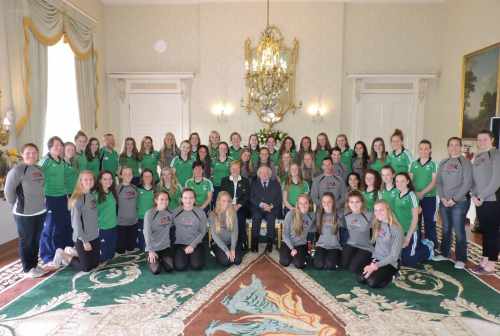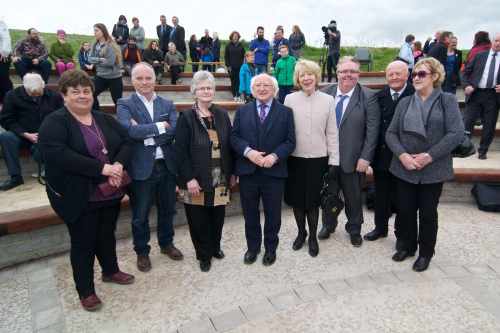Address at the opening of ‘Portrait of a Century’
Collins Barracks, 20 April 2017
Dear friends,
A chairde,
Is mian liom mo bhuíochas a ghabháil leis an grianghrafadóir Kim Haughton, le Stiúrthóir Mhúseam Náisiúnta na hÉireann, Ragnall Ó Floinn agus le mo chara Sheamus Smith as ucht a gcuiridh caoin dom a bheith libh anocht.
[May I thank the photographer, Kim Haughton, the Director of the National Museum of Ireland, Ragnall O Floinn and my friend Sheamus Smith for the kind invitation to be with you this evening.]
It is my pleasure to open this beautiful exhibition of photographs by Kim Haughton, here, at the National Museum of Ireland, Collins Barracks. Ever since the Barracks’ reopening as a Museum, twenty years ago, these galleries have played an important role in fostering public appreciation and understanding of Irish history, and I am delighted to have the opportunity, this evening, to share with you all in Kim Haughton’s multi-faceted – or, I should say, hundred-faced – journey through the century just gone by.
As Sabina and I walked through this exhibition, a few moments ago, Kim’s photographs struck me as a celebration of one, perhaps eclectic aspect of our country’s greatest wealth – the diversity of its people and the range of their backgrounds and contributions. These images constitute a powerful evocation of the bounty of ideas, achievements, vulnerabilities, and commitments of an intellectual, political, artistic or sporting kind, that have shaped our collective destiny throughout those ten decades.
It is very apt indeed that this photo series is entitled “Portrait of a Century”, inviting us as it does to revisit, through the combined powers of memory and imagination, all those gifts of the hand, mind, heart and soul, through which successive generations of Irish people have contributed to transform and heighten the life of our nation.
Kim Haughton has sought to capture the essence of each of the hundred years that have elapsed since the seminal events of Easter 1916 through the portrait of a man, woman or child born in each year of the century. Her project, a successful one, starts with one of the great architects of modern Ireland, T.K. Whitaker, and ends with young Rebecca, Jaymin, Charlie and Dan, for whom the future is brimming with possibilities, perhaps yet unknown to us today.
Each portrait reflects, or, more accurately, thanks to Kim’s talent, suggests with subtlety, the uniqueness of its subject. Taken together, the hundred of them offer a sweeping visual account of a vibrant, diverse and changing Ireland.
As we gaze at Kim’s compelling portrayal of the poet, the Benedictine, the singer, the judge, the female rally driver, the wood turner, the winner of the young scientists’ exhibition, the politician, the doctor, the filmmaker, the cook and so many others, all of us are invited to meditate on what has constituted work, life, experience for these subjects, the choices they made, or which were imposed upon them, to respond to the infinite possibilities that should exist for human achievement, and on the vast opportunities, and the limitations, for fulfilment that this island has afforded, or allowed, and it suggests to us too what we must continue to provide for, both those who were born on it and those who come to its shore in pursuit of a better life for themselves and their children.
We are invited to reflect, too, on change, on the passage of time and generations – pausing in front of the portraits of those, such as T.K. Whitaker, Leslie Greer or Tom Murphy, reminding ourselves of how the vision and achievements of each generation influenced the shaping of the horizons of those who succeed it.
Photography, and portrait photography, in particular, is a fascinating art but a highly demanding genre, one that which striving for a subtle intimacy requires a cooperation between the photographer and his subject, a willingness for revelation in the latter, as the former seeks to capture some authentic trait of the latter’s inner life.
What emerges may of course be serendipitous, and must recognise the arbitrariness of choice and the ephemerality of all images.
This ability to pierce through outward appearances so as to reveal human frailty, or folly, or fortitude, is what distinguishes the work of the great portrait photographers, such as Marcel Sternberger, or Diane Arbus, or Richard Avedon, or Henri Cartier-Bresson, or indeed Colman Doyle, whose portrait appears in this exhibition, marking the year 1932. It is also, of course, a quality that is discernible in the work of the great portrait painters of previous centuries.
Francisco Goya, for example, had an extraordinary ability to reveal the character of his sitters, even in his most formal portraits of the Spanish royal family. He was an artist who knew to combine insightful observation and technical mastery to reveal, through a subtle look, or a simple gesture, personality features that were not always flattering for his subject, that perhaps unconsciously revealed a dark side, a flaw of character or of moral intent. His portrait of “Ferdinand VII” is a case in point, I think. It is offered as conventionally perfect, yet it nevertheless reveals Goya’s mistrust of the pompous and vengeful monarch who abolished the constitution and reintroduced the Inquisition. Art in some of its best intentions inclines towards the subversive, even when it has been commissioned.
The portraitist’s gifts of perceptive observation, humour, and above all, empathy, are evident in Kim Haughton’s work. This empathy is one I experienced at first hand during the time I spent with Kim as she was taking my own portrait, and we see those powers of empathy reflected throughout the whole series, in all those portraits that capture something of the human vulnerability, the history, the wry or sceptical view of life, or the aspirations, of the people they represent.
Kim Haughton’s achievement is all the more remarkable in our contemporary age of visual saturation, when we find ourselves so often surrounded by a myriad of images, and in particular repeated, sometimes even franchised, images of what are referred to as ‘celebrities’, that often blend into a stupefying hollowing out of meaning and difference, a worship of notice-seeking that is banal, without context. Kim’s sensitive and differentiated approach to her various subjects, her carefully composed images, succeed in avoiding the pitfalls of stereotyping, uniformity, and triviality.
Alternating between classic close-up portraits and wide-shots, between interior and exterior settings, Kim’s photographs often thwart our expectations. Paul McGrath, for example, is uprooted from the football pitch and transplanted to a forest scene immersed in an uncanny Celtic twilight atmosphere, with roots of ferns hiding his legendary feet.
The brilliant iconic poet, Máire Mhac an tSaoi, sits, formidable and elegantly dressed, in a small back garden invaded by weeds and whose tranquillity seems far removed from her exceptional life as a trailblazing Irish diplomat at the United Nations General Assembly, but who are we to assume. Her reflections might also alternatively, or in addition, include those heady days of 1916 which her father, Seán McEntee, spent fighting in the GPO, her conversations with such intellectual figures as Pádraig de Brún, and of course her life partner, Conor Cruise O’Brien.
The portrait of Eunice Adeleye, born in 2007, also uproots pre-conceptions, or expectations. Two wheel tracks lead us into a beautifully structured image of a black-skinned girl dressed in that white First Communion dress which evokes a milestone rite of passage for so many generations of Irish children. Yet, instead of being captured amongst the familiar surroundings of the church steps and proud relatives, Eunice stands against big blue skies and expansive horizons, summoning us to a compelling reflection on tradition, identity, place, renewal and possibility.
We may even discern invisible connections in the female experience between the 95-year old woman, who was the first woman to be called to the bar in Ireland, and whose poetry speaks, in the beautiful Irish of the Munster Gaeltacht, of the female experience of love, and the 10-year old girl, whose prospects and expectations are sustained, made possible today by the work of generations of courageous women who went before her, and those who supported them.
The image that springs to mind is one I have invoked last year, during our historic commemorations of the centenary of the Easter Rising: “Casann an roth. The wheel always turns.” What generations have created, beautiful, flawed and full of promise, we now entrust to the next. We wish them all well as they continue to grow, create, make music and friends, and as they carry on their dreams.
Beir Beannacht is go raibh míle maith agaibh go léir.


